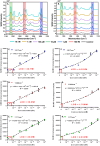DNA-directed formation of plasmonic core-satellite nanostructures for quantification of hepatitis C viral RNA
- PMID: 38817589
- PMCID: PMC11134388
- DOI: 10.1039/d4sc00891j
DNA-directed formation of plasmonic core-satellite nanostructures for quantification of hepatitis C viral RNA
Abstract
Hepatitis C virus (HCV) continues to be a significant public health challenge, affecting an estimated 71 million people globally and posing risks of severe liver diseases. Despite advancements in treatments, diagnostic limitations hinder the global elimination efforts targeted by 2030. This study introduces an innovative diagnostic approach, integrating catalytic hairpin assembly (CHA) with plasmonic core-satellite gold nanoparticle (AuNP) assemblies, to enable sensitive and specific detection of HCV RNA. We optimized the stoichiometry of DNA hairpins to form highly stable three-way junctions (3WJs), minimizing non-specific reactions in an enzyme-free, isothermal amplification process. The resulting dual-transduction biosensor combines colorimetric and surface-enhanced Raman spectroscopy (SERS) techniques, utilizing the Raman reporter malachite green isothiocyanate (MGITC) for signal generation. Our system targets a conserved 23-nucleotide sequence within the HCV 5'-UTR, essential for RNA replication, facilitating pan-genotypic HCV detection that complements direct-acting antiviral strategies. We evaluated the biosensor's efficacy using fluorescence spectroscopy, native PAGE, AFM, and TEM. Findings indicate that the 60 nm core AuNPs surrounded by 20 nm satellite AuNPs achieved a ten-fold increase in sensitivity over the 10 nm satellites, detecting HCV RNA concentrations as low as 1.706 fM. This sensitivity is crucial, given the extremely low viral loads present during early infection stages. Our research demonstrates the promise of enzyme-free molecular biosensors for HCV, with the potential to provide cost-efficient, rapid, point-of-care testing, although further sensitivity enhancements are needed to address the challenges of early-stage detection.
This journal is © The Royal Society of Chemistry.
Conflict of interest statement
There are no conflicts to declare.
Figures







Similar articles
-
SPR/SERS dual-mode plasmonic biosensor via catalytic hairpin assembly-induced AuNP network.Biosens Bioelectron. 2021 Oct 15;190:113376. doi: 10.1016/j.bios.2021.113376. Epub 2021 May 29. Biosens Bioelectron. 2021. PMID: 34098358
-
Enzyme-free sensitive SERS biosensor for the detection of thalassemia-associated microRNA-210 using a cascade dual-signal amplification strategy.Anal Chim Acta. 2024 Mar 1;1292:342255. doi: 10.1016/j.aca.2024.342255. Epub 2024 Jan 16. Anal Chim Acta. 2024. PMID: 38309848
-
DNA Assembly of Plasmonic Nanostructures Enables In Vivo SERS-Based MicroRNA Detection and Tumor Photoacoustic Imaging.Anal Chem. 2023 Aug 1;95(30):11236-11242. doi: 10.1021/acs.analchem.3c00775. Epub 2023 Jul 19. Anal Chem. 2023. PMID: 37467354
-
Growth of Spherical Gold Satellites on the Surface of Au@Ag@SiO2 Core-Shell Nanostructures Used for an Ultrasensitive SERS Immunoassay of Alpha-Fetoprotein.ACS Appl Mater Interfaces. 2019 Jan 23;11(3):3617-3626. doi: 10.1021/acsami.8b21238. Epub 2019 Jan 11. ACS Appl Mater Interfaces. 2019. PMID: 30608142
-
Simplification of hepatitis C testing: a time to act.Acta Dermatovenerol Alp Pannonica Adriat. 2020 Sep;29(3):129-132. Acta Dermatovenerol Alp Pannonica Adriat. 2020. PMID: 32975299 Review.
Cited by
-
Exploring the diffusion of DNA strands into nanoporous structures for establishing a universal electrochemical biosensor.Chem Sci. 2024 Dec 30;16(5):2420-2428. doi: 10.1039/d4sc05833j. eCollection 2025 Jan 29. Chem Sci. 2024. PMID: 39790983 Free PMC article.
References
LinkOut - more resources
Full Text Sources
Miscellaneous

